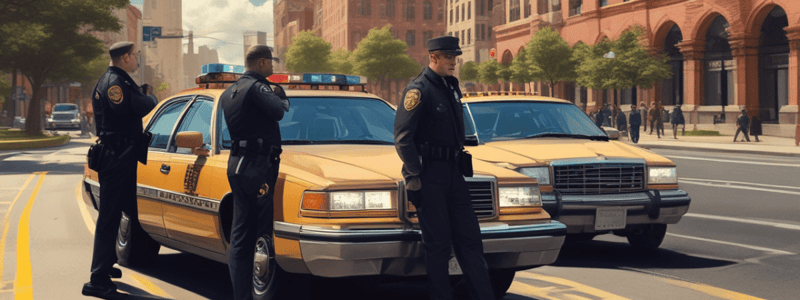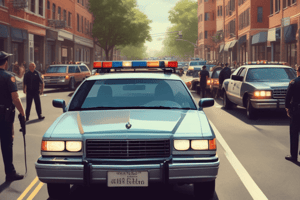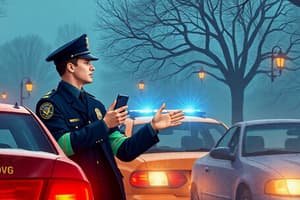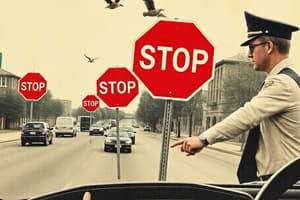Podcast
Questions and Answers
What is the primary goal of every traffic stop?
What is the primary goal of every traffic stop?
- To issue a uniform traffic citation or warning
- To make an arrest
- To promote driver education and safer roadways (correct)
- To provide help to someone in need
How can you minimize negative and potentially unsafe results in a traffic stop?
How can you minimize negative and potentially unsafe results in a traffic stop?
- By conducting yourself professionally and following your training (correct)
- By being confrontational and aggressive
- By ignoring the driver's concerns
- By speaking loudly and sternly
What should you do when communicating with the driver during a traffic stop?
What should you do when communicating with the driver during a traffic stop?
- Immediately ask for their driver's license and registration
- Tell the driver what they did wrong and why they are being stopped
- Ask the driver if they are carrying any weapons
- Greet the driver and passengers politely, introduce yourself and your agency, and explain why you stopped them (correct)
Why is it important to describe the violation in terms of what you saw the vehicle do, rather than the driver?
Why is it important to describe the violation in terms of what you saw the vehicle do, rather than the driver?
What should you do if a driver becomes upset or angry during a traffic stop?
What should you do if a driver becomes upset or angry during a traffic stop?
What is an important aspect of maintaining officer safety during a traffic stop?
What is an important aspect of maintaining officer safety during a traffic stop?
What is the purpose of establishing a command presence during a traffic stop?
What is the purpose of establishing a command presence during a traffic stop?
What should you do if you encounter a language barrier during a traffic stop?
What should you do if you encounter a language barrier during a traffic stop?
What is a possible reason why a driver may not immediately pull over during a traffic stop?
What is a possible reason why a driver may not immediately pull over during a traffic stop?
What should an officer do if an interpreter is not available during a traffic stop?
What should an officer do if an interpreter is not available during a traffic stop?
How can officers communicate with drivers who have hearing impairments?
How can officers communicate with drivers who have hearing impairments?
What is a key component of fostering positive relationships with members of the community during a traffic stop?
What is a key component of fostering positive relationships with members of the community during a traffic stop?
What should officers do when communicating with people during a traffic stop?
What should officers do when communicating with people during a traffic stop?
What is an important consideration when initiating a traffic stop?
What is an important consideration when initiating a traffic stop?
Why is it important for officers to explain their actions during a traffic stop?
Why is it important for officers to explain their actions during a traffic stop?
What is a key goal of a traffic stop?
What is a key goal of a traffic stop?
What is the main reason for the backup officer not to use front emergency lighting during a traffic stop?
What is the main reason for the backup officer not to use front emergency lighting during a traffic stop?
When approaching the driver's vehicle, which side of the primary officer's vehicle should the backup officer walk along?
When approaching the driver's vehicle, which side of the primary officer's vehicle should the backup officer walk along?
What is the primary purpose of conducting a visual assessment of the driver's vehicle and occupants?
What is the primary purpose of conducting a visual assessment of the driver's vehicle and occupants?
What should the officer do if the occupants try to exit their vehicle during a traffic stop?
What should the officer do if the occupants try to exit their vehicle during a traffic stop?
What is a potential indicator of criminal activity when conducting a visual assessment of the vehicle?
What is a potential indicator of criminal activity when conducting a visual assessment of the vehicle?
What should the officer do before exiting their patrol vehicle during a traffic stop?
What should the officer do before exiting their patrol vehicle during a traffic stop?
Why is it important to exit the patrol vehicle quietly during a traffic stop?
Why is it important to exit the patrol vehicle quietly during a traffic stop?
What should the officer do with their portable radio volume during a traffic stop?
What should the officer do with their portable radio volume during a traffic stop?
What should you observe about the vehicle during a traffic stop?
What should you observe about the vehicle during a traffic stop?
What should you observe about the driver and passengers during a traffic stop?
What should you observe about the driver and passengers during a traffic stop?
What is the primary purpose of notifying dispatch during a traffic stop?
What is the primary purpose of notifying dispatch during a traffic stop?
Why is location information crucial during a traffic stop?
Why is location information crucial during a traffic stop?
What should you provide to dispatch during an unknown risk traffic stop?
What should you provide to dispatch during an unknown risk traffic stop?
Why is it important to select a safe location to initiate the traffic stop?
Why is it important to select a safe location to initiate the traffic stop?
What should you do if the final stop location changes during a traffic stop?
What should you do if the final stop location changes during a traffic stop?
When interacting with a driver, what should you identify yourself as?
When interacting with a driver, what should you identify yourself as?
What is the primary reason for providing a description of the driver's vehicle to dispatch?
What is the primary reason for providing a description of the driver's vehicle to dispatch?
What should you describe to the driver when explaining the reason for the stop?
What should you describe to the driver when explaining the reason for the stop?
Why should you ask the driver where they keep their documentation?
Why should you ask the driver where they keep their documentation?
How should the driver retrieve their license from their wallet?
How should the driver retrieve their license from their wallet?
What should you do if the driver claims to have a medical condition that explains the violation?
What should you do if the driver claims to have a medical condition that explains the violation?
What should you pay close attention to when the driver reaches for their documents?
What should you pay close attention to when the driver reaches for their documents?
What tone should you maintain during the interaction with the driver?
What tone should you maintain during the interaction with the driver?
Why should you ask the driver to retrieve their documents slowly?
Why should you ask the driver to retrieve their documents slowly?
When should you not make a traffic stop?
When should you not make a traffic stop?
What should you consider when deciding to follow a vehicle for an extended period before initiating a traffic stop?
What should you consider when deciding to follow a vehicle for an extended period before initiating a traffic stop?
What is the primary purpose of Step 2 in initiating an unknown risk traffic stop?
What is the primary purpose of Step 2 in initiating an unknown risk traffic stop?
Why should you observe the vehicle from the time of the violation until you complete the stop?
Why should you observe the vehicle from the time of the violation until you complete the stop?
What should you do if you encounter a situation where stopping a driver for a traffic violation may endanger you or other motorists?
What should you do if you encounter a situation where stopping a driver for a traffic violation may endanger you or other motorists?
What is an important consideration when selecting a safe location to stop a vehicle?
What is an important consideration when selecting a safe location to stop a vehicle?
What should you do if you are driving to an emergency call or an in-progress crime and encounter a reckless driver?
What should you do if you are driving to an emergency call or an in-progress crime and encounter a reckless driver?
Why should you use defensive driving techniques when following a vehicle through traffic?
Why should you use defensive driving techniques when following a vehicle through traffic?
What should you do when interacting with the driver during a traffic stop?
What should you do when interacting with the driver during a traffic stop?
When should you exit your vehicle and use available cover for safety during a high-risk traffic stop?
When should you exit your vehicle and use available cover for safety during a high-risk traffic stop?
Why should you describe the violation in terms of what you saw the vehicle doing, rather than the driver?
Why should you describe the violation in terms of what you saw the vehicle doing, rather than the driver?
What should you do if the driver reaches for their documents in the glove compartment?
What should you do if the driver reaches for their documents in the glove compartment?
What should you do if the driver pulls away after you initiate the stop?
What should you do if the driver pulls away after you initiate the stop?
Why should you not accept a wallet from the driver?
Why should you not accept a wallet from the driver?
What should you do if the suspect vehicle stops and any suspects flee the vehicle?
What should you do if the suspect vehicle stops and any suspects flee the vehicle?
What should you do if the driver claims to have a medical condition that explains the violation?
What should you do if the driver claims to have a medical condition that explains the violation?
What should you do if the supervisor advises against pursuing or advises canceling the pursuit at any time?
What should you do if the supervisor advises against pursuing or advises canceling the pursuit at any time?
What should you do if the suspect vehicle begins to flee from the stop and then crashes?
What should you do if the suspect vehicle begins to flee from the stop and then crashes?
What should you pay close attention to when the driver reaches for their documents?
What should you pay close attention to when the driver reaches for their documents?
Why should you ask the driver where they keep their documentation?
Why should you ask the driver where they keep their documentation?
What should you do during a high-risk traffic stop after all officers are in position?
What should you do during a high-risk traffic stop after all officers are in position?
How should the driver retrieve their license from their wallet?
How should the driver retrieve their license from their wallet?
What should you do before initiating a pursuit?
What should you do before initiating a pursuit?
What should you do during a high-risk traffic stop to ensure officer safety?
What should you do during a high-risk traffic stop to ensure officer safety?
When stopping a driver on the right side of the road, where should you position your patrol vehicle?
When stopping a driver on the right side of the road, where should you position your patrol vehicle?
What is the purpose of angling the patrol vehicle when stopping a driver on the right side of the road?
What is the purpose of angling the patrol vehicle when stopping a driver on the right side of the road?
When conducting a traffic stop on the left side of the road, where should you position your patrol vehicle?
When conducting a traffic stop on the left side of the road, where should you position your patrol vehicle?
What should the backup officer do when arriving at the scene of a traffic stop?
What should the backup officer do when arriving at the scene of a traffic stop?
Why should you turn your wheels away from traffic when parking your patrol vehicle during a traffic stop?
Why should you turn your wheels away from traffic when parking your patrol vehicle during a traffic stop?
When stopping a driver on the right side of the road, how far behind the driver's vehicle should you position your patrol vehicle?
When stopping a driver on the right side of the road, how far behind the driver's vehicle should you position your patrol vehicle?
What should you do if the driver stops on the right side of the road and you need to improve safety and reduce the obstruction of traffic?
What should you do if the driver stops on the right side of the road and you need to improve safety and reduce the obstruction of traffic?
Why is the offset-angle position important when stopping a driver on the right side of the road?
Why is the offset-angle position important when stopping a driver on the right side of the road?
What should you instruct the last passenger exiting the vehicle to do?
What should you instruct the last passenger exiting the vehicle to do?
What is the purpose of the 'plus one rule' in removing passengers from a suspect's vehicle?
What is the purpose of the 'plus one rule' in removing passengers from a suspect's vehicle?
What should you do if a discovered passenger refuses to come out of the vehicle?
What should you do if a discovered passenger refuses to come out of the vehicle?
Who should unlock the trunk of the vehicle during a search?
Who should unlock the trunk of the vehicle during a search?
What should you do after the interior of the vehicle is cleared?
What should you do after the interior of the vehicle is cleared?
What should you do if you encounter a crossfire position when searching the trunk?
What should you do if you encounter a crossfire position when searching the trunk?
What should you do after the scene is secure and all is safe?
What should you do after the scene is secure and all is safe?
What should you follow when searching the vehicle?
What should you follow when searching the vehicle?
Flashcards are hidden until you start studying
Study Notes
Communication with Drivers during Traffic Stops
- The goal of every traffic stop is to promote driver education and safer roadways, which may involve issuing a uniform traffic citation or warning, making an arrest, or providing help.
- Decreasing tension and increasing cooperation during traffic stops can be achieved by exercising procedural justice, remaining professional, and following training.
- To practice procedural justice and reduce tension, follow these steps:
- Greet the driver and passengers politely, introduce yourself and your agency, and explain the reason for the stop.
- Request the driver's license, registration, and proof of insurance, and explain the violation in terms of the vehicle's actions.
- Allow the driver to talk or vent, remaining polite and focused while conveying that you are listening.
- Maintain a pleasant expression, calm tone, and non-confrontational interview stance while prioritizing officer safety.
- Establish a command presence by using professional and respectful language.
- If a language barrier exists, request an interpreter through dispatch or try to communicate using gestures or writing notes.
- For drivers with hearing impairments, writing notes or using a passenger as an interpreter may be necessary.
Initiating a Safe and Professional Unknown Risk Traffic Stop
- Traffic stops are among the most frequent activities performed by officers, and it's essential to note the vehicle's description, including its type, make, model, year, color, plate number, and state of issue.
- Observe the driver and any passengers for unique identifiers, such as glasses, hat, hair, or beard.
- When initiating a traffic stop, follow these steps:
- Step 2: Notify dispatch of the traffic stop, providing essential information, including your radio identification number, location, vehicle description, license plate number, and state of issue.
- Step 3: Select a safe location to initiate the stop, considering factors such as traffic conditions and backup officer positioning.
- Step 6: Conduct a visual assessment of the driver's vehicle and occupants, looking for signs of danger or criminal activity.
- Step 7: Exit the patrol vehicle quickly, quietly securing the door, adjusting your portable radio volume, and continuously observing the driver's vehicle and occupants.
Best Practices during Traffic Stops
- When interacting with the driver, begin by identifying yourself as a law enforcement officer, especially if you're not in uniform.
- Display a courteous but commanding presence, using professional, respectful, and polite language and body language.
- Explain the reason for the stop, describing what you observed the vehicle doing, and request the required documentation.
- Allow the driver to offer an explanation, and contact dispatch for medical assistance if necessary.
- Request the driver's license, registration, and insurance information, asking them to remove it slowly and predictively from a wallet or compartment.
Circumstances for Lawful Traffic Stop
- Making a traffic stop may not be practical in situations where you are driving to an emergency call or an in-progress crime, or transporting a prisoner.
- However, a reckless driver who is immediately endangering the lives of others may justify a stop, even if stopping means abandoning an earlier call.
- Agency policies will dictate what takes priority in these situations.
Steps for Initiating an Unknown Risk Traffic Stop
- Follow the vehicle through traffic until it is safe to make the traffic stop.
- Notify dispatch of the traffic stop.
- Select a safe location to stop.
- Activate emergency equipment to communicate the stop to the driver.
- Use defensive driving techniques to catch up with the vehicle, follow at a safe distance, and signal all lane changes.
- Consider calling for backup, based on your agency policies and procedures.
Parking the Patrol Vehicle
- Park the patrol vehicle a safe distance behind the driver's vehicle, about 1½–2-car lengths behind the vehicle.
- If the driver stops on the right side of the road, position the patrol vehicle in the offset-angle position.
- Align the center of the patrol vehicle's hood with the tail light of the driver's vehicle and point the vehicle's nose outward into the flow of traffic.
- Turn the wheels away from traffic.
- Angling the vehicle may also provide cover if the driver shoots a weapon.
Positioning the Backup Patrol Vehicle
- The backup officer should park their patrol vehicle at a safe distance behind the primary officer's vehicle.
- When interacting with the driver, begin by identifying yourself as a law enforcement officer, especially if you are not in uniform.
Interacting with the Driver
- Display a courteous but commanding presence to avoid resistance.
- Explain the reason for the stop and describe what you observed the vehicle doing.
- Request the required documentation and allow the driver to offer an explanation.
- Ask the driver to provide their driver's license, registration, and insurance information.
- Pay close attention to both of the driver's hands when they reach for the documents.
Taking Cover Using the Patrol Vehicle
- Exit your vehicle and use available cover for safety after the suspect's vehicle has stopped and all patrol vehicles are positioned.
- The patrol vehicle is usually the most effective and readily available cover.
- Once all officers are in position, they should draw their firearms and point them at the suspect's vehicle with their fingers outside the trigger guard.
Pursuit Considerations
- If the driver pulls away after you initiate the stop, make a second attempt to pull over the vehicle.
- If the driver does not stop, the primary officer must decide whether the situation is legal, feasible, necessary, and meets their agency's criteria for pursuit.
- If a supervisor advises against pursuing or advises canceling the pursuit at any time, all officers must comply.
Removing Passengers from the Suspect's Vehicle
- Hold a brief discussion to determine the roles of the responding officers.
- Instruct the last passenger exiting the vehicle to leave the door open, and make sure all passengers are secured and separated when possible.
- Command any hidden passengers to make themselves known.
Clearing and Searching the Vehicle
- If there is no response to the command, more than one officer should cautiously approach the suspect's vehicle with their weapons pointed at it.
- The officer with the best vantage point should give commands to any discovered passenger.
- After the interior is clear, retrieve the keys or remote to open the trunk and cautiously approach the trunk area.
- Move cautiously to the trunk area when attempting to clear it.
Concluding the Stop
- After the scene is secure and all is safe, the primary officer notifies dispatch to discontinue emergency radio traffic.
- Follow proper arrest procedures if you are arresting the driver or any passengers.
Studying That Suits You
Use AI to generate personalized quizzes and flashcards to suit your learning preferences.





